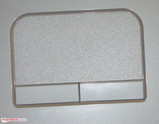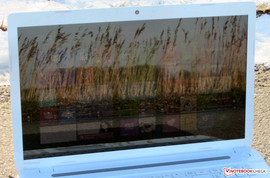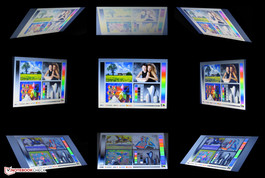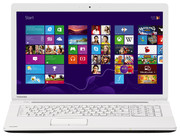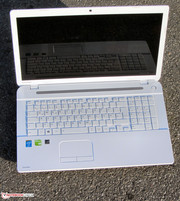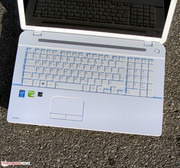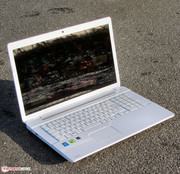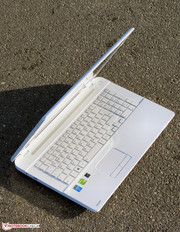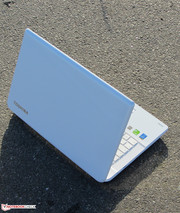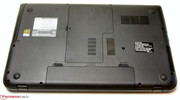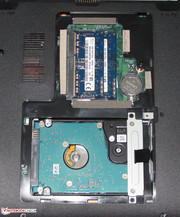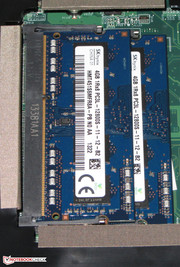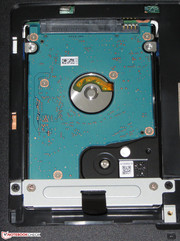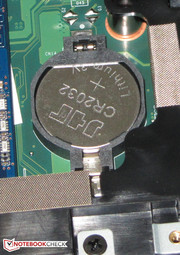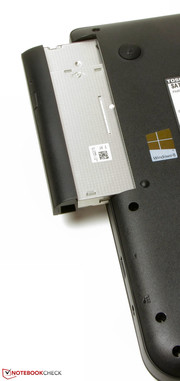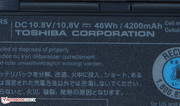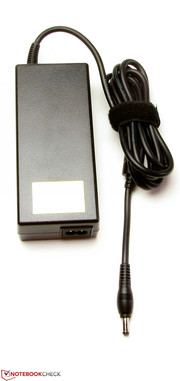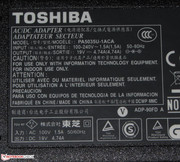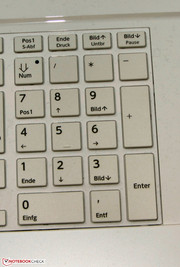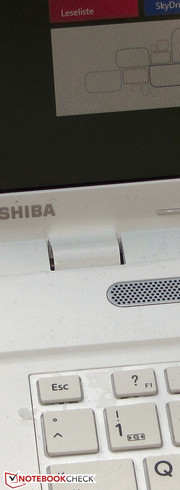Review Toshiba Satellite C75-A-13W Notebook

For the original German review, see here.
Toshiba has a 17.3-inch, all-round laptop dubbed Satellite C75-A-13W in its line. The device should satisfy the needs of most users with its combination of a strong processor and plenty of storage. Even casual gamers will be able to make use of the laptop. The Satellite is no stranger to us; we have tested models from the largely identically built C70D and C75D series, for example the Satellite C70D-A-10L (AMD A4-5000, Radeon HD 8330). These lines are powered by AMD processors. The Satellite C70D-A-10L only achieved "Good" with 77%. Our review will reveal whether the C75-10-13W does a better job.
We used the Lenovo G710 (Core i7-4702MQ, GeForce GT 720M), and the HP ProBook 470 (Core i7-3632QM, Radeon HD 8750M) to classify the laptop.
Since the Satellite C75-A-13W has a lot in common with the Satellite C70D-A-10L, we will not deal any closer with the casing, connectivity or speakers, except for the differences. The corresponding information can be read in the review of the C70D.
Case
As said earlier, the C75-A-13W, and the C70D-A-10L are largely identical. However, slight differences exist. The most obvious difference: The C75 features a white casing (only the underside is black plastic), in contrast to the C70D with a black casing. The surfaces also differ; the C75's surfaces are sleek and glossy. Toshiba relies on matte surfaces in the C70D. Besides that, the lid's back and wrist rest are textured (grooves).
Connectivity
Operating System
Toshiba delivers the Satellite with the newest (64-bit) Windows 8.1 version. A Windows DVD is not included, and it is thus recommendable to create recovery media via the pre-loaded Toshiba Recovery Media Creator. That enables re-installing the system after, for example, swapping the hard drive. DVDs or a USB flash drive can be used for the backup. It should also be easily possible to replace the installed Windows 8.1 with Windows 7; Toshiba provides drivers for Windows 7, 8, and 8.1.
Maintenance
There is a maintenance cover on the laptop's underside that enables accessing the working memory, BIOS battery, and hard drive. The laptop has two working memory banks that are both filled with a 4 GB module each. The hard drive is easy to replace with 2.5-inch drives with a height of 7 or 9.5 mm in contrast to the C70D.
Input Devices
Keyboard
Unlike the C70D, Toshiba installs a chiclet keyboard in the C75-A-13W. The main keys feature a size of 15 x 15 mm. The keys are even and lightly roughened. They have a short drop, and the pressure point is clear. However, their resistance could be considerably crisper. The keyboard itself yields evidently while typing on it. Generally, the keyboard is acceptable for home usage, but users who type regularly should look for another laptop.
Touchpad
Although there is enough room, Toshiba only installs a rather small multi-touchpad (with a size of approximately 8.1 x 4.7 mm). The roughened surface allows the finger to glide easily. Not all available multi-touch gestures are enabled by default. The single gestures can be enabled or disabled in the setup menu. Both mouse buttons feature a sleek surface, and have a clearly audible and palpable pressure point.
Display
| |||||||||||||||||||||||||
Brightness Distribution: 83 %
Center on Battery: 137 cd/m²
Contrast: 300:1 (Black: 0.73 cd/m²)
ΔE ColorChecker Calman: 9.42 | ∀{0.5-29.43 Ø4.78}
ΔE Greyscale Calman: 11.28 | ∀{0.09-98 Ø5}
48.8% AdobeRGB 1998 (Argyll 1.6.3 3D)
54.7% AdobeRGB 1998 (Argyll 3D)
75% sRGB (Argyll 3D)
53% Display P3 (Argyll 3D)
Gamma: 2.41
CCT: 14082 K
The screen's contrast of 300:1 and black level of 0.73 cd/m² are not very compelling. A 700 Euros (~$951) laptop should have more to offer in this regard. The ProBook (272:1, 0.87 cd/m²) achieves even poorer rates. However, the G710 (1178:1, 0.23 cd/m²) offers outstanding rates. None of the three laptops can reproduce the sRGB or AdobeRGB color spaces. These color spaces are, for example, interesting for professional image editing. The Satellite's screen covers sRGB by 65.9% and AdobeRGB by 48.8%.
The average DeltaE 2000 shift is 9.4. Thus, it is roughly on a par with the rates of most screens that we have assessed. Only the colors yellow-green and yellow are within the target range of DeltaE smaller than 3. The screen has a bluish cast.
The laptop is unsuitable for outdoor use. The screen's maximum brightness drops to 137 cd/m² in battery mode. This is accompanied by a low contrast and reflective surface.
The screen's viewing angle stability is not convincing either. The horizontal angle is generous, and several people can look at the screen simultaneously. The content can also still be read from the sides. However, the image darkens with an increasing angle. The image soon distorts when the vertical viewing angle on the screen is altered.
Performance
The Satellite is an all-round laptop in a 17.3-inch size. The installed Core i5 processor is strong enough to deal with all tasks. The GeForce graphics chip allows playing current games to a limited extent. Our review sample is presently sold for approximately 700 Euros (~$951). Toshiba offers various other models within the C75-A line besides the C75-A-13W. The differences are found in processor, graphics chip, working memory capacity, and hard drive capacity. The currently lowest priced model from the series sports a Pentium 2020M, 4 GB of working memory, and a 500 GB hard drive for around 400 Euros (~$543).
Processor
The Satellite sports the Core i5-4200M dual-core processor from Intel. It comes from the latest Haswell processor generation. The CPU clocks with a base speed of 2.5 GHz. Its speed can be boosted up to 3 GHz (both cores), and 3.1 GHz (one core only) via Turbo. Intel specifies the TDP of this standard mobile processor (not ULV) with 37 watts.
The Core i5 processed the Cinebench single-thread tests with 3 GHz. One core was occasionally boosted to 3.1 GHz. The multi-thread tests ran consistently with 3 GHz. The Core i7 in the G710 (Core i7-4702MQ, GeForce GT 720M) can show its slightly higher Turbo speed here. The Satellite cannot keep up with either contender in the multi-thread test because they both feature a quad-core processor. The G710 achieves the best results. The ProBook (Core i7-3632QM, Radeon HD 8750M) is still powered by an Ivy Bridge processor that has a bit less performance per MHz than the Haswell processor in the G710. The ProBook has the lead in the GL tests because it sports the strongest graphics core.
System Performance
The system ran smoothly, and we did not experience any problems. The results of the different PCMark benchmarks also confirmed this impression. The G710 (Core i7-4702MQ, GeForce GT 720M), and the ProBook (Core i7-3632QM, Radeon HD 8750M) only provide marginally better scores than the Satellite. Both contenders benefit from their quad-core here.
Users who install a solid state drive in the Satellite can speed up the system performance even more. The system responds faster, and the time needed for booting Windows is much shorter. This action also leads to better PCMark scores. We tried it: Our Crucial Real SSD C300 - 64 GB SSD improved the Satellite's PCMark 7 score by about 73% to 5184 points.
| PCMark Vantage Result | 6379 points | |
| PCMark 7 Score | 3001 points | |
| PCMark 8 Home Score Accelerated v2 | 2686 points | |
| PCMark 8 Creative Score Accelerated v2 | 2631 points | |
| PCMark 8 Work Score Accelerated v2 | 3237 points | |
Help | ||
Storage Devices
Toshiba installs a hard drive from its own product line in the Satellite. It has a capacity of 1 TB and spins with 5400 revolutions per minute. CrystalDiskMark recorded a read speed of 110.1 MB/s, and HD Tune delivered an average transfer rate of 87.3 MB/s. These are good rates for a 5400 rpm hard drive. We generally found the drive to be good as it works swiftly, and has a high storage capacity.
Graphics Card
An Optimus array comprised of Intel's HD Graphics 4600 GPU and the GeForce 710M graphics core takes care of graphics output. Intel's core is responsible for routine use and in battery mode. The GeForce chip takes over when high performance applications, such as 3D computer games, are demanded. The GeForce graphics core belongs to the entry-level category. It clocks with speeds up to 797 MHz.
The ProBook (Core i7-3632QM, Radeon HD 8750M) clearly wins the different 3DMark benchmarks. It sports the strongest graphics core. The scores of both the Satellite and the G710 (Core i7-4702MQ, GeForce GT 720M) are quite close. After all, both laptops sport the same graphics core. The GPU in the G710 only clocks with a higher speed.
| 3DMark 06 Standard Score | 7405 points | |
| 3DMark Vantage P Result | 4572 points | |
| 3DMark 11 Performance | 1218 points | |
| 3DMark Ice Storm Standard Score | 55422 points | |
| 3DMark Cloud Gate Standard Score | 4537 points | |
| 3DMark Fire Strike Score | 725 points | |
Help | ||
| Toshiba Satellite C75-A-13W GeForce 710M, 4200M, Toshiba MQ01ABD100 | HP ProBook 470 G0-H6P56EA Radeon HD 8750M, 3632QM, HGST Travelstar 5K1000 HTS541075A9E680 | Lenovo G710 59397112 GeForce GT 720M, 4702MQ, Seagate Momentus SpinPoint M8 ST1000LM024 HN-M101MBB | Acer Aspire V3-772G-747A321 GeForce GTX 760M, 4702MQ, Toshiba HG5d THNSNH256GMCT | |
|---|---|---|---|---|
| 3DMark | 50% | 6% | 120% | |
| 1280x720 Ice Storm Standard Score (Points) | 55422 | 58505 6% | 50811 -8% | 79494 43% |
| 1280x720 Cloud Gate Standard Score (Points) | 4537 | 7521 66% | 5443 20% | 11171 146% |
| 1920x1080 Fire Strike Score (Points) | 725 | 1281 77% | 779 7% | 1971 172% |
Gaming Performance
The Satellite can smoothly render most computer games in low resolutions, and low quality levels. Games also often still run smoothly in HD resolution, and higher quality settings, e.g. StarCraft II: Heart of the Swarm or Grid 2. Titles with lower hardware requirements should still be playable even using higher quality settings. This, for example, includes the various editions from the FIFA series. Since the installed GPU is Nvidia's weakest model, a comparison with Intel's integrated GPUs would seem plausible. The GeForce core clearly defeats the HD Graphics 4600 graphics core in direct comparison, and delivers considerably higher frame rates as can be seen in the comparison chart.
The ProBook generally offers a bit more gaming power. The HP laptop model that we tested is sold for just under 800 Euros (~$1087). The laptop with a Core i5-4200M processor is available for 700 Euros (~$951), and is on par with the Satellite. Acer's Aspire V3-772G (Core i7-4702MQ, GeForce GTX 760M) is one or two performance levels higher than the ProBook. The Aspire V3-772G-54204G50Makk with a Core i5-4200M, GeForce GTX 760M, and matte Full HD screen is available for just under 700 Euros (~$951). However, it does not include a Windows operating system. The Aspire should be first choice when focus is placed on computer games.
| low | med. | high | ultra | |
|---|---|---|---|---|
| The Elder Scrolls V: Skyrim (2011) | 40.2 | 28.5 | ||
| Diablo III (2012) | 84.8 | 60.7 | 52.9 | |
| Sleeping Dogs (2012) | 53.6 | 39.6 | 16.1 | |
| Hitman: Absolution (2012) | 37.9 | 22.9 | ||
| Dead Space 3 (2013) | 95.8 | 43.9 | 33.8 | |
| Tomb Raider (2013) | 68.2 | 33.3 | 18.9 | |
| StarCraft II: Heart of the Swarm (2013) | 197.3 | 58.2 | 28.8 | |
| BioShock Infinite (2013) | 51.6 | 28.2 | ||
| Metro: Last Light (2013) | 26 | |||
| GRID 2 (2013) | 101.3 | 51.2 | 33.9 | |
| Saints Row IV (2013) | 38.9 | 30.6 | 11.8 | |
| F1 2013 (2013) | 89 | 61 | 51 | |
| Battlefield 4 (2013) | 40.1 | 26.5 | 16.5 |
| Toshiba Satellite C75-A-13W GeForce 710M, 4200M, Toshiba MQ01ABD100 | Lenovo G710 59397112 GeForce GT 720M, 4702MQ, Seagate Momentus SpinPoint M8 ST1000LM024 HN-M101MBB | HP ProBook 470 G0-H6P56EA Radeon HD 8750M, 3632QM, HGST Travelstar 5K1000 HTS541075A9E680 | Acer Aspire V3-772G-747A321 GeForce GTX 760M, 4702MQ, Toshiba HG5d THNSNH256GMCT | Lenovo ThinkPad Edge E540 20C60041 HD Graphics 4600, 4000M, Hitachi Travelstar Z7K500 HTS725050A7E630 | |
|---|---|---|---|---|---|
| Tomb Raider | 3% | 221% | -39% | ||
| 1024x768 Low Preset (fps) | 68.2 | 69.2 1% | 42.3 -38% | ||
| 1366x768 Normal Preset AA:FX AF:4x (fps) | 33.3 | 34.5 4% | 99 197% | 20.3 -39% | |
| 1366x768 High Preset AA:FX AF:8x (fps) | 18.9 | 19.4 3% | 65 244% | 11.2 -41% | |
| F1 2013 | -11% | 10% | |||
| 1024x768 Ultra Low Preset (fps) | 89 | 64 -28% | 92 3% | ||
| 1366x768 Medium Preset (fps) | 61 | 58 -5% | 66 8% | ||
| 1366x768 High Preset AA:2x MS (fps) | 51 | 51 0% | 60 18% | ||
| Diablo III | -5% | 182% | -52% | ||
| 1024x768 Low / off (fps) | 84.8 | 80.5 -5% | 45.06 -47% | ||
| 1366x768 Medium / low (fps) | 60.7 | 57.7 -5% | 168 177% | 28.63 -53% | |
| 1366x768 High AA:on (fps) | 52.9 | 49.5 -6% | 152 187% | 23.17 -56% | |
| Total Average (Program / Settings) | -4% /
-4% | 3% /
2% | 202% /
201% | -46% /
-46% |
Emissions
System Noise
The Satellite is relatively quiet in idle mode. The fan is sometimes inactive. However, the hard drive's base noise is always audible. Consequently, the noise level ranges from 33 to 33.8 dB. Overall, the G710 (32.6 to 34 dB) and the ProBook (32.3 dB) achieve similar rates. The speed of the Satellite's fan increases during medium load via 3DMark06, and full load in the stress test via Prime95 and Furmark. The laptop's noise correspondingly increases to 38.6 and 43.3 dB. The ProBook (39.3 and 43.7 dB) delivers similar rates. The G70 provides slightly better rates (34.6 and 40.4 dB).
Noise level
| Idle |
| 33 / 33.7 / 33.8 dB(A) |
| DVD |
| 37.4 / dB(A) |
| Load |
| 38.6 / 43.3 dB(A) |
 | ||
30 dB silent 40 dB(A) audible 50 dB(A) loud |
||
min: | ||
Temperature
The exteriors of all three review samples barely warm up in idle mode. The temperatures at the single measuring points are all within an acceptable range. This is also largely true for load. However, both the Satellite and the Probook exceed 50 °C at one measuring point. The G710 barely heats up during load. The ascertained maximum temperature was 36.8 °C. However, we should keep in mind that the G710's CPU and GPU are recurrently throttled.
The Satellite performed the stress test (Prime95 and Furmark run for at least one hour) in the same manner in both AC and battery mode. The CPU and GPU always clocked at full speed (CPU: 3 GHz; GPU: 797 MHz). The CPU's temperature settled to approximately 87 °C in the stress test (AC mode).
(+) The maximum temperature on the upper side is 36.3 °C / 97 F, compared to the average of 36.9 °C / 98 F, ranging from 21.1 to 71 °C for the class Multimedia.
(-) The bottom heats up to a maximum of 52.3 °C / 126 F, compared to the average of 39.2 °C / 103 F
(+) In idle usage, the average temperature for the upper side is 26.6 °C / 80 F, compared to the device average of 31.3 °C / 88 F.
(+) The palmrests and touchpad are reaching skin temperature as a maximum (32.5 °C / 90.5 F) and are therefore not hot.
(-) The average temperature of the palmrest area of similar devices was 28.7 °C / 83.7 F (-3.8 °C / -6.8 F).
Energy Management
Power Consumption
The Satellite's idle power consumption ranged from 7 to 11.4 watts. The G710's rates (6.5 to 10.5 watts) are on par with that, and the ProBook consumes more (10.8 to 16.2 watts). The Satellite's requirement increased to 51.3 watts in medium load via 3DMark06, and to 72.8 watts during full load in the stress test via Prime95 and Furmark. Both the G710 (63 and 93 watts) and the ProBook (55.3 and 88.2 watts) consume more power. This was to be expected since both sport a quad-core processor and stronger graphics cores.
| Off / Standby | |
| Idle | |
| Load |
|
Key:
min: | |
Battery Runtime
The Satellite's battery lasted for 7:24 h in idle mode, and is very close to the runtime of the G710 (7:39 h). The ProBook (5:41 h) shuts down much sooner. Idle mode is checked using Battery Eater's Reader's test; the screen is set to minimum brightness, the energy-saving profile is enabled, and the wireless modules are off. The C75-A is drained after 0:51 h of load. The ProBook (0:49 h) is on par with that, and the G710 (1:07 h) only lasts a few minutes longer. The load runtime is ascertained using Battery Eater's Classic test. The screen's brightness is set to maximum, and both the high-performance profile and wireless modules are enabled here.
The Wi-Fi test ran for 3:28 h on the Satellite. Both the G710 (3:30 h) and the ProBook (3:17 h) achieve similar times. For this test, websites are opened automatically every 40 seconds, the energy-saving profile is enabled, and the screen's brightness is set to approximately 150 cd/m². The Satellite stopped DVD playback after 2:57 h. The ProBook (2:57 h) achieves an equal time but the G710 (2:38 h) cannot keep up with either contender. The DVD test is performed using the energy-saving profile (or a higher profile should the DVD not run smoothly), maximum screen brightness, and disabled wireless modules.
The runtime of the three laptops can be compared well because their batteries have roughly the same capacity (Toshiba: 48 Wh; Lenovo: 48 Wh; HP: 47 Wh). The Satellite's runtimes are absolutely acceptable for a 17.3-inch all-round laptop.
The time needed to recharge the battery was noticed adversely. The Satellite needed approximately 8 - 9 hours to completely recharge the battery. This is much too long. We can only hope that we had a device with faulty charging electronics, and that this does not apply to all models.
Verdict
Toshiba's Satellite C75-A-13W scores with a good application performance. Beyond that, it should also satisfy users who want to play an occasional game. The laptop offers plenty of storage capacity, and can offer decent battery runtimes. The latter is, however, rather secondary for such a laptop. The device's biggest shortcoming is its screen. Here Toshiba provides a low-contrast model with a bluish cast. Lenovo proves that there's no need for this with its G710.
The advantages of HP's ProBook 470 are found in its matte screen, and good keyboard. It also has more gaming power than the Satellite. Lenovo's G710 is interesting when a lot of CPU performance is wanted. Besides that, both it and the ProBook feature superior and extensive maintenance options.





